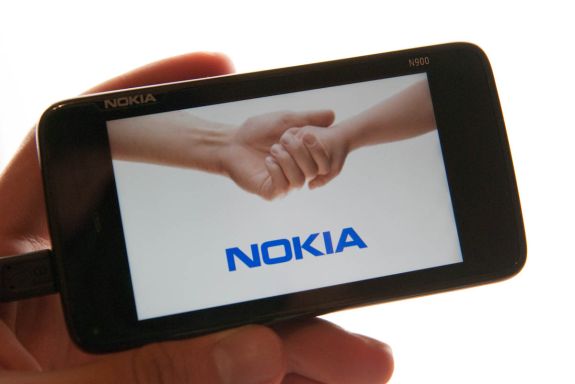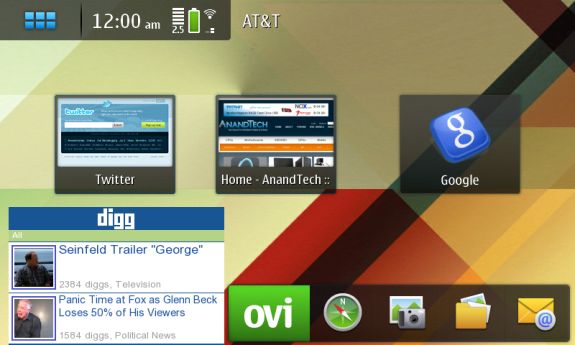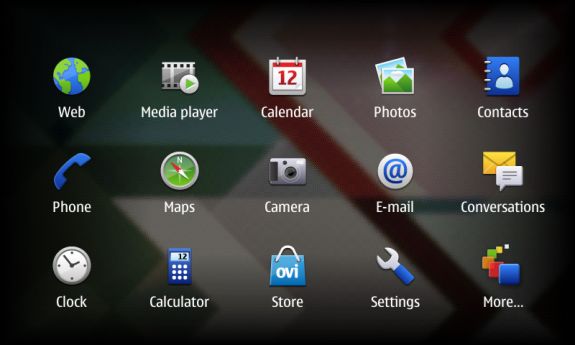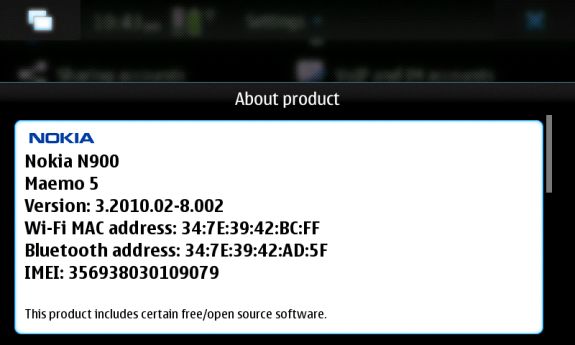Two OMAP 3430 Phones: Nokia N900 and Motorola Droid
by Brian Klug on June 10, 2010 9:29 PM EST- Posted in
- Smartphones
- N900
- Maemo
- Motorola Droid
- Droid
- MeeGo
- Android
- Mobile
Maemo is Debian
That really brings us to what we haven't talked in depth about before; Maemo. Nokia's Maemo operating system started - as I mentioned earlier - as a tablet operating system for the N770, and saw updates for the N800, and N810. As it stands now, all three legacy internet tablets can run up thorough Maemo 4.1.
The N900, however, launched with and continues to exclusively run Maemo 5. The N900 we played with was flashed to PR 1.1, and recently Nokia released PR 1.2 - unfortunately just a few days after we had to part ways with our N900. PR 1.2 brings bugfixes and a few new features to the platform, including support for Skype and Google Talk video calling (which I'll get to in a moment), performance increases for the core OS and browser JavaScript engine, and Qt 4.6.2. The core of the Maemo OS remains largely the same however.
Maemo is derived from Debian and runs natively compiled code, uses GNOME for much of the UI, has an X-Window system, and uses BusyBox core utilities. For all intents and purposes, using Maemo is exactly like using almost any other computer running Debian. What other phone seriously ships with X Terminal installed and presented front and center in the launcher? It really is a bona-fide handheld computer by day, smartphone by night.
In Maemo 5, up at the top is the menu and status bar. This is a bit of a strange departure for earlier Maemo users who likely are used to the same bar being at the left. Regardless, tapping on the icon at top left from the desktop brings up the application launcher, which consists of a 5 by 3 grid of applications overlaid on a beautiful defocused version of your desktop. What's really impressive is how buttery smooth the transition from desktop to launcher is; no doubt a huge testament to some GPU acceleration on the OMAP 3430's PowerVR SGX.
Getting to the next page of apps is unfortunately not a scroll gesture away, instead, you have to tap more in the bottom right corner. This is something that has changed in PR 1.2 however, as 'more' has been removed in favor of touch scrolling, and apps can be rearranged.
This out-of-focus blur is a consistent UI element that acts as Maemo's way of establishing what many on the desktop would identify as window 'focus.' Of course, in this context, it's more likely to be applied to a menu or some launched property panel.
For example, tapping and holding for a copy/paste or save file command brings up a blurry background surrounding the new property window. It's impressive how smooth this transition is, I just can't stress it enough.















68 Comments
View All Comments
tarunactivity - Thursday, June 10, 2010 - link
a notable omission:The FM receiver on the N900 requires Bluetooth to be switched on. So if you want FM, you need to plugin your earphones + enable bluetooth.
Kind of counter productive , if you ask me,and surely a waste of power.
Brian Klug - Friday, June 11, 2010 - link
Ahh, you're totally right. I think I glossed over that because I already had Bluetooth on, but it makes sense now since the FM radio is on that same piece of silicon.I wonder how much of a difference it makes on battery - had it disabled for those other tests of course.
-Brian Klug
asdasd246246 - Thursday, June 10, 2010 - link
I'm sure the Nokia has sweet hardware, but it's still all plastic..Plastic screen that will scratch the first 10 minutes you own it, and a friend has a similar model without a keyboard, and the plasticness is so horrible I shudder.. -_-
legoman666 - Thursday, June 10, 2010 - link
I've had the N900 since last November. No screen protector, no case. Not 1 scratch. So speak for yourself, maybe you ought to put your phone in a separate pocket as your keys.legoman666 - Thursday, June 10, 2010 - link
back: http://imgur.com/tf6RE.jpgfront: http://imgur.com/XDsyI.jpg
akse - Friday, June 11, 2010 - link
The case is somewhat plastic yeah.. but it hasn't really bothered me so much. I have only a few tiny tiny scratches on the screen, you can only spot them by mirroring a clean screen against bright light.At the back I have a few bigger scratches because the phone fell on concrete..
Calin - Friday, June 11, 2010 - link
I have a 1200-series Nokia phone, which I keep in the same pocket as the keys, and the display is in a serviceable condition after more than two years of abusearnavvdesai - Thursday, June 10, 2010 - link
Actually, the Symbian OS- Nokia's No.1 Smartphone OS is more open with entire OS(including the core APIs) being Open Source. Symbian is more open than Android.Talcite - Friday, June 11, 2010 - link
That's only true for symbian^3 and newer OSes. Only the Nokia N8 is currently shipping S^3 I believe.You should also mention that the Maemo 5 OS has many binary packages to get all the cellular hardware and PowerVR GPU working.
Anyways, it definitely has more support for the FOSS community than android though as far as I know. You're free to flash your own ROMs without needing to root it and you don't need to do weird stuff with java VMs. Just a simple recompile for ARM and support for Qt I think.
teohhanhui - Friday, June 11, 2010 - link
Nokia N8 is still far from "currently shipping"...